Open uping Space Beneath Your Staircase
A cabinet stair is a dual-purpose staircase that incorporates storage space within or underneath the steps, maximizing otherwise wasted areas in your home.
Quick Guide to Cabinet Stair Options: - Step Tansu: Japanese-inspired staggered cabinet steps - Under-stair Cabinets: Custom drawers and doors beneath the staircase - Bookcase Stairs: Integrated shelving along staircase walls - Pull-out Drawers: Hidden storage within individual treads - Wine Storage: Temperature-controlled racks in the stair void
According to home organization experts, installing under-stair storage drawers or cabinets is one of the most effective ways to maximize space in small homes. Custom under-stair cabinetry can increase available storage space by up to 30% in otherwise unused areas.
The beauty of a cabinet stair lies in its versatility. Whether you need a place for emergency equipment, everyday items, or display-worthy collections, the space beneath your steps offers endless possibilities. From practical mudroom lockers to neat wine cellars, these ingenious solutions transform a purely functional element into a hardworking feature of your home.
My name is Mortuary Cooler, and while I primarily specialize in mortuary cooling solutions, I've helped numerous funeral homes optimize their spaces with cabinet stair installations that provide discreet storage for supplies and equipment. My experience with space-efficient design translates perfectly to helping you find the hidden potential beneath your steps.
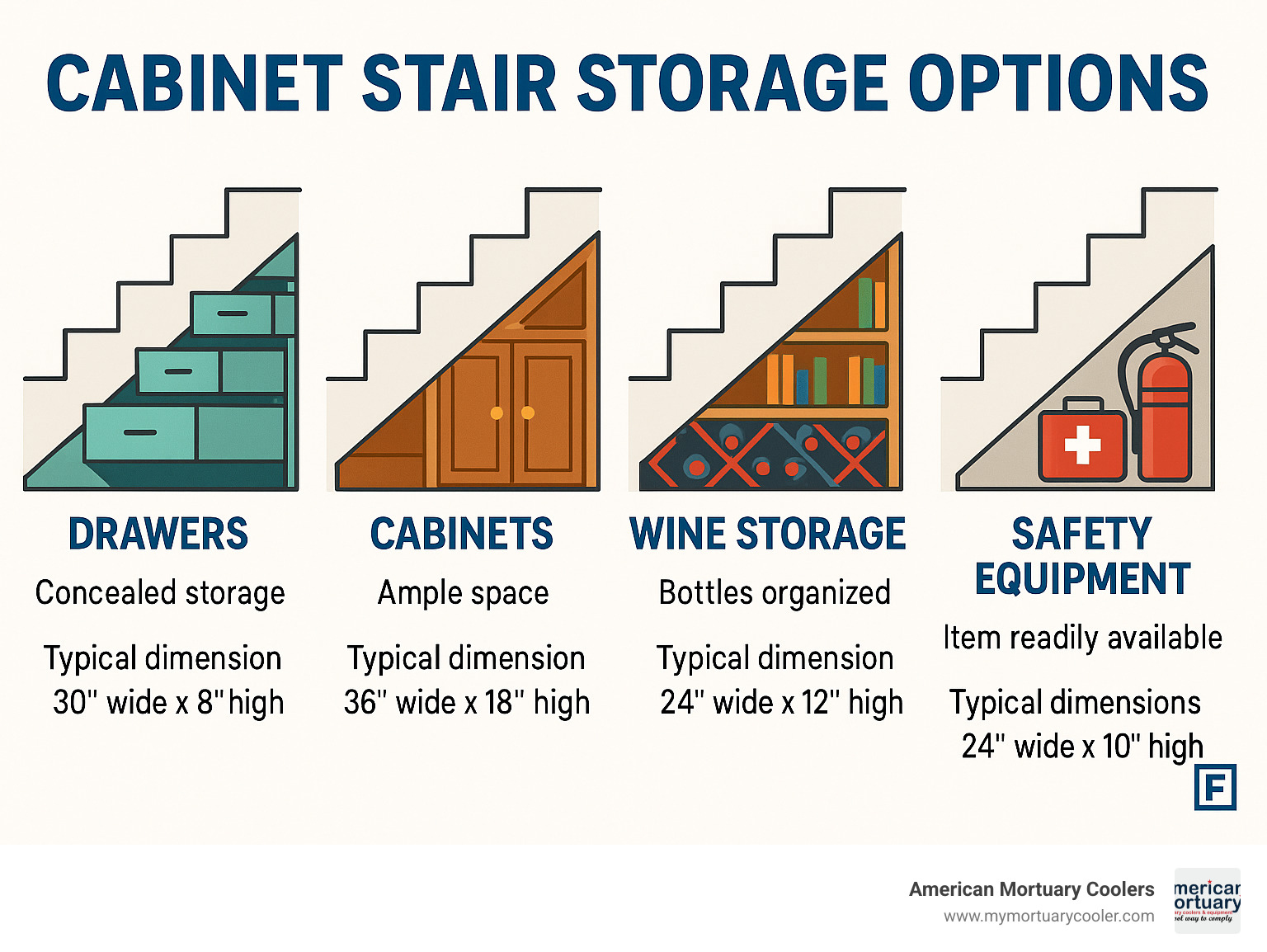
Cabinet stair terms to remember: - funeral home supply companies - gerni bed - patient mover
What Is a Cabinet Stair? Definition & Benefits
Imagine walking up your stairs and being able to pull out a drawer for your keys, open a cabinet for your shoes, or reveal a hidden wine collection—all from the same structure that gets you from one floor to another. That's the magic of a cabinet stair.
These clever designs trace their roots back to Japanese "step tansu"—those beautifully crafted staggered storage cabinets that served double-duty as stairs in space-conscious homes. Today, this concept has blossomed into sophisticated storage staircases that blend seamlessly with any home's aesthetic while solving your storage dilemmas.
What makes cabinet stairs truly remarkable is their efficiency. By changing that hollow void beneath your staircase into functional storage, you're not just gaining cabinets—you're reclaiming up to 30% more storage space without sacrificing a single square foot of your floor plan. It's like finding a hidden room you never knew existed!
Beyond just stashing away your stuff, a thoughtfully designed cabinet stair brings multiple benefits to your home. They help eliminate clutter from living spaces, creating a more peaceful environment. They add significant resale value—today's homebuyers are increasingly prioritizing clever storage solutions. They provide perfect homes for specialized items that might otherwise be awkwardly stored elsewhere. And perhaps most visibly, they transform a purely functional architectural element into a conversation-worthy feature of your home.
Want to take your staircase functionality even further? More info about stair pulley systems can help you understand additional options for making your stairs work harder for your home.
Difference From Traditional Staircases
Traditional staircases are essentially one-trick ponies—they get you up and down, but that's about it. They typically feature either open treads that allow light to pass through or enclosed steps with that notorious void underneath (you know, where dust bunnies go to multiply).
Cabinet stairs, however, are overachievers. They transform that void into functional storage through some clever engineering:
First, they incorporate load-bearing drawers that aren't your typical furniture components. These are specially designed to support significant weight while still opening and closing smoothly after years of use.
Second, they accept dual-function design where every element serves both a structural and a storage purpose. Nothing is wasted—not space, not materials.
Third, they feature custom integration where storage elements are built into the structural framework rather than tacked on as an afterthought. This seamless approach ensures both safety and aesthetics.
This integration does mean that cabinet stairs require thoughtful engineering. You can't simply hollow out your existing stairs and expect them to hold your holiday decorations safely. Professional installation is typically recommended to ensure all structural and safety standards are maintained.
Top Benefits in One Glance
When considering a cabinet stair for your home, the advantages stack up quickly:
Space optimization transforms wasted areas into valuable storage, giving you back up to 30% more space in your home. Organization improvement creates dedicated homes for specific items, from seasonal decorations to everyday essentials. Safety equipment storage provides discreet yet accessible space for first aid kits, fire extinguishers, or emergency supplies—particularly valuable for families.
Your home also gets an aesthetic upgrade as utilitarian stairs become a design feature worthy of showing off. This contributes to value addition by increasing your home's functional square footage and appeal to future buyers. The customization options let you tailor the storage to your specific needs and home style—whether that's vintage charm or modern minimalism.
The multi-functionality allows you to combine different storage types within one staircase—perhaps display shelves near the top and deep drawers at the bottom. And finally, the decluttering solution keeps essential items accessible but beautifully concealed, supporting a more peaceful living environment.
At American Mortuary Coolers, we've seen how smart storage solutions transform spaces in commercial settings—and the same principles apply beautifully to your home. While we typically help funeral homes optimize their spaces, the principles of maximizing every square inch apply universally. Your staircase is waiting to do more for you than just connect your floors!
12 Hidden Treasures: Cabinet Stair Ideas That Wow
The magic of cabinet stair designs lies in their incredible versatility. Whether you're a wine enthusiast, bookworm, or busy parent, there's a clever way to transform that often-wasted space beneath your staircase into something truly special. Let me walk you through twelve inspiring ideas that could revolutionize your home storage.
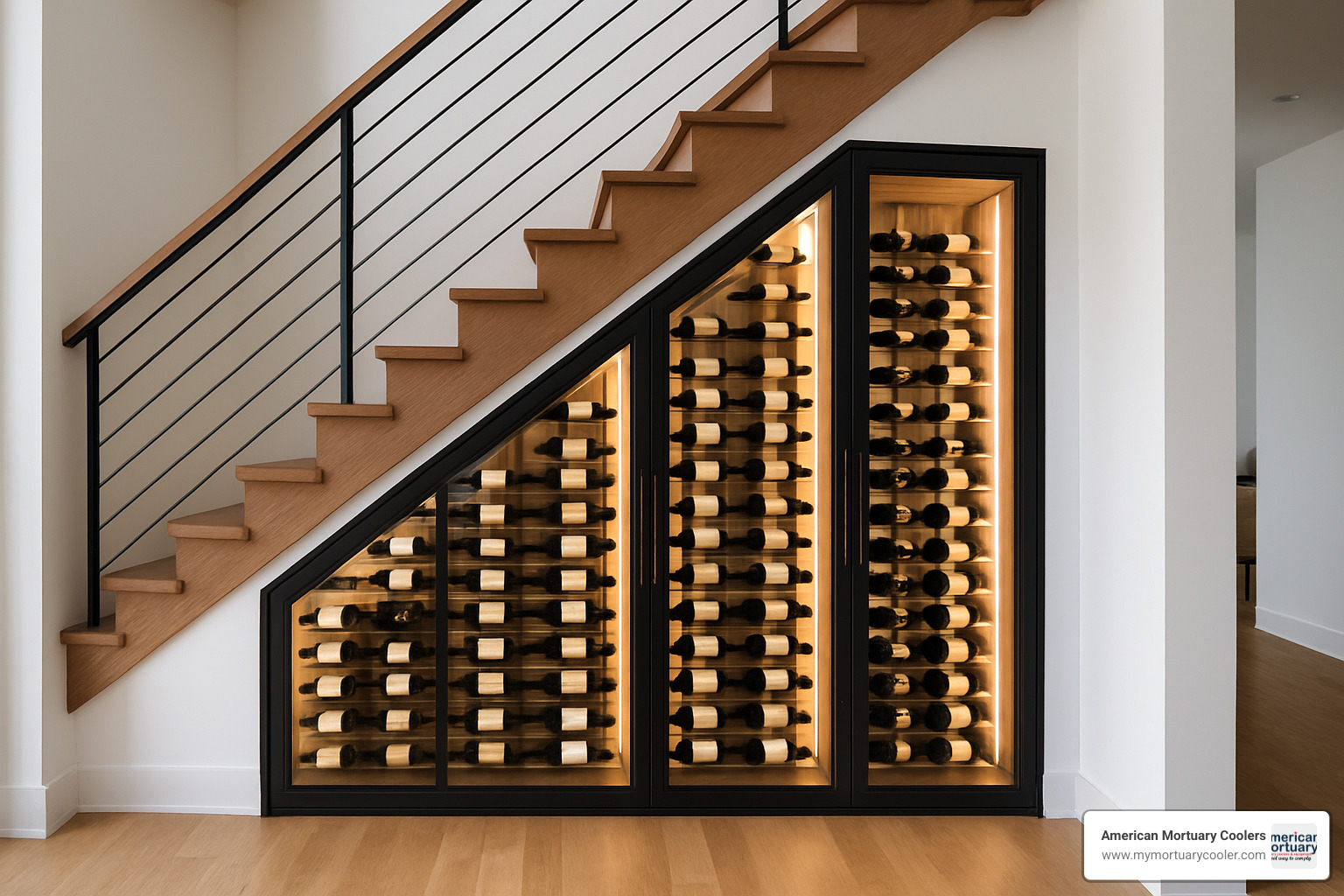
Wine Cellar Cabinet Stair Showcase
Wine lovers, rejoice! The angled space beneath your stairs creates a naturally perfect environment for wine storage. A well-designed wine cellar cabinet stair transforms this void into a temperature-controlled haven that both protects and showcases your collection.
Imagine neat glass-front racks that display your prized bottles while keeping them safe from light and temperature fluctuations. The natural temperature gradient that forms beneath a staircase is actually ideal for storing different wine varieties – cooler at the bottom, slightly warmer toward the top. Add some soft LED lighting to highlight your collection, and you've got a conversation piece that rivals dedicated wine rooms in much larger homes.
My clients are often surprised at how a relatively small under-stair space can store 50-100 bottles when properly designed. It's truly one of the most sophisticated ways to use your cabinet stair potential.
Style your staircase wine room
Bookshelf Cabinet Stair for Avid Readers
For the book lovers among us, a bookshelf cabinet stair is nothing short of dreamy. The stepped nature of a staircase naturally creates the perfect cascading display for your literary treasures.
I've helped design several of these for clients who wanted to showcase their collections while maintaining easy access. The Japanese-inspired step tansu approach works beautifully here, creating a visual flow that draws the eye. For taller staircases, we often incorporate a sliding ladder system that adds both functionality and old-world library charm.
What makes these designs special is how they can be personalized – dedicated shelves for oversized art books at the bottom, paperbacks up top, and perhaps even a cozy reading nook tucked into the lowest section. The warm glow of books beneath your stairs creates an inviting atmosphere throughout your entire home.
Mudroom & Coat Closet Combo
Let's talk practical magic. The entryway to your home often becomes a dumping ground for shoes, coats, bags, and everyday essentials. A thoughtfully designed mudroom cabinet stair can transform this chaos into calm.
I recommend creating individualized storage for each family member – their own shoe cubby, hook for coats, and small drawer for gloves and accessories. The beauty of this setup is how it establishes natural organization habits, especially for children. When everyone knows exactly where their things belong, morning routines become significantly smoother.
Many of my clients also incorporate a small bench at the base of these stairs, creating a dedicated spot for putting on and removing footwear. It's these thoughtful touches that lift a simple storage solution into a life-enhancing feature of your home.
Evacuation Chair & Safety Niche
Safety equipment is essential in many homes and buildings, but finding appropriate storage can be challenging. That's where a specialized safety cabinet stair design comes in, providing discreet yet instantly accessible storage for emergency equipment.
The MOBI Evac Stair Chair Storage Cabinet deserves special mention here. These cabinets are specifically engineered to house evacuation chairs, with dimensions (typically 16" deep x 28" wide x 48" high) that accommodate most standard models. What makes these cabinets remarkable is their quick-access functionality – they open in seconds during emergencies while remaining unobtrusive during everyday life.
For commercial buildings and homes with residents who have mobility challenges, this specialized cabinet stair solution isn't just convenient – it could be life-saving. The cabinets can also incorporate emergency lighting that activates automatically when opened, ensuring visibility even during power outages.
More info about stair stretcher
Kids Playroom Hideout
There's something magical about secret spaces, especially for children. A cabinet stair playroom transforms the area beneath your stairs into an enchanted hideaway that sparks imagination and creativity.
I've seen children's faces light up when we reveal these custom spaces with their child-sized doorways that make the area feel special and exclusive. Adding chalkboard paint to the interior walls creates an ever-changing canvas for artistic expression. Soft, warm lighting and comfortable built-in seating make these nooks perfect for reading trips or quiet play.
The beauty of these playroom hideouts is how they give children their own dedicated space without requiring an entire room. In open-concept homes where play areas might otherwise take over living spaces, these tucked-away havens keep toys contained while giving kids a sense of ownership and privacy.
Beyond these five stellar ideas, your cabinet stair could also become a pantry drawer system with custom dividers for different food items, a secure bike cubby with pull-out racks for easy access, or a spacious linen closet with adjustable shelving. Pet owners might appreciate a cozy pet den with built-in feeding stations, while entertainers might opt for a compact wet bar with an integrated mini-fridge. Collectors could showcase treasures in a display alcove with museum-quality lighting, or you might simply need an extra coat closet with seasonal rotation capabilities.
The possibilities are truly endless when you start thinking creatively about that space beneath your stairs. At American Mortuary Coolers, we've applied these same space-maximizing principles to help funeral homes optimize their facilities – proving that smart storage solutions work in every setting.
Planning, Materials & Cost: Your Cabinet Stair Roadmap
Turning that empty space under your stairs into a beautiful, functional cabinet stair isn't just about picking pretty cabinets. It requires thoughtful planning, the right materials, and a realistic budget. Let's walk through everything you need to know before you start knocking down walls!
Measurement & Code Checklist
Before you get too excited about your dream cabinet stair, grab that measuring tape and check your local building codes. Safety always comes first!
Your stairs need to maintain standard measurements for safe daily use—typically a 7" rise and 11" run per step. Don't forget about headroom either; most building codes require at least 6'8" of clearance so you don't bump your head when using the stairs.
Fire safety is non-negotiable, so make sure your design doesn't block any emergency exit routes. Your cabinet stair needs to handle everyday traffic too, so pay attention to weight load ratings for both the stairs and the storage components.
One often overlooked detail? Door swing clearances. Those beautiful cabinet doors need enough space to open fully without hitting walls or passersby. Trust me, nothing's more frustrating than a cabinet you can only open halfway!
Most towns and cities require permits for structural changes to staircases, so chat with a professional before you start tearing things apart. It's much easier to do things right the first time than to fix code violations later.
Material Selection Guide
The materials you choose for your cabinet stair will determine how it looks, how long it lasts, and how much it costs. Let's explore your options:
Oak remains a popular choice for cabinet stairs because of its durability and distinctive grain patterns. It stands up beautifully to high-traffic areas, which is exactly what you need for stairs. Walnut offers richer, darker tones for a more luxurious feel, though it requires a bit more TLC. If you prefer lighter woods, ash is strong yet lightweight and takes stain beautifully.
Not ready to splurge on solid hardwood? Engineered materials offer practical alternatives. MDF provides a smooth finish that's perfect for painted cabinets at a fraction of the cost, though it won't handle moisture or heavy impacts as well as solid wood. Quality plywood—especially 19-ply hardwood varieties—offers impressive strength with a natural wood appearance. For the eco-conscious homeowner, bamboo provides a sustainable option with its own unique character.
For the structural elements of your cabinet stair, consider steel stringers that provide maximum support without visual bulk. Don't skimp on drawer glides either—heavy-duty options can support up to 100 pounds per drawer, which you'll appreciate when storing books or wine bottles.
When choosing materials, think beyond just looks. Consider how moisture-resistant the material needs to be (especially important for wine storage), how well it will handle scratches in high-traffic areas, and whether it meets sustainability standards like FSC certification if that's important to you. And for families with allergies or sensitivities, pay attention to VOC emissions that might affect your indoor air quality.
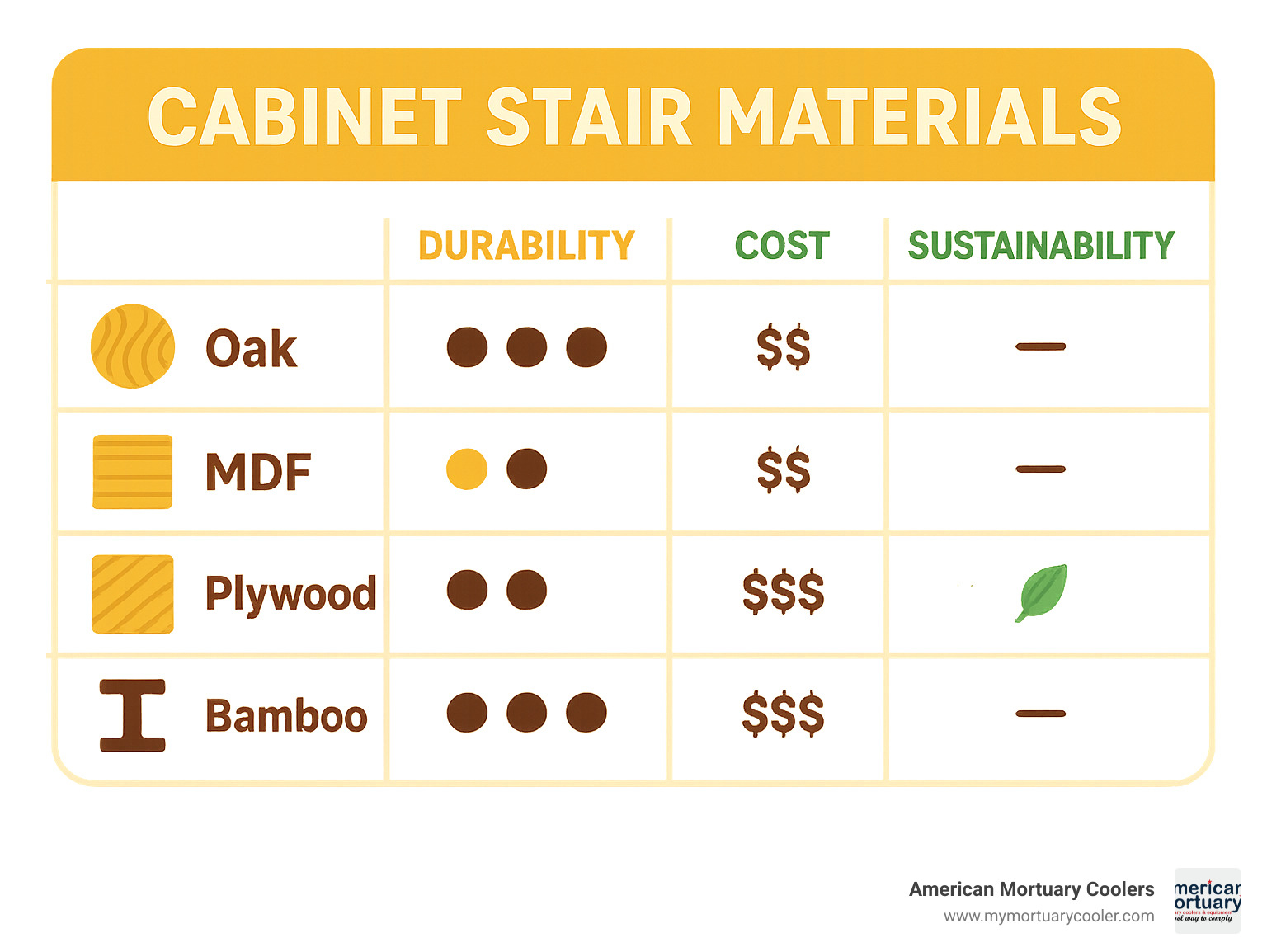
Budget Factors
Let's talk money—how much should you expect to spend on your cabinet stair project?
The price range is wide, starting around $2,000 for a basic DIY conversion and climbing to $20,000+ for high-end designer solutions. Most homeowners find themselves somewhere in the middle, spending between $5,000-$12,000 for a quality custom installation.
What drives these costs? Design complexity is a major factor—simple drawers cost significantly less than rotating storage systems or pull-out mechanisms. Your material selection plays a huge role too, with hardwoods and metals commanding premium prices compared to engineered materials.
Don't forget about hardware! Those soft-close drawer slides and specialized hinges might seem like small details, but they can add up quickly. The same goes for labor requirements—custom work requires skilled craftspeople who (rightfully) charge for their expertise. And if you're in a hurry, expect to pay extra for rushed timelines.
Custom cabinet stairs offer a perfect fit and maximum storage utilization, but they come with a premium price tag. Prefabricated systems cost less but might not make the most of your unique space. Many homeowners find the sweet spot with a hybrid approach—professional structural work with DIY finishing touches.
If the full cost feels overwhelming, consider these financing approaches: home improvement loans can help with larger projects, and some energy-efficient storage solutions may even qualify for rebates. You might also consider a phased implementation to spread costs over time—start with the basic structure and add custom features as your budget allows.
More info about best stair chair lifts
At American Mortuary Coolers, we understand the importance of maximizing space while maintaining functionality—it's something we help funeral homes with every day. While our specialty is mortuary equipment, the principles of smart storage design apply whether you're storing embalming supplies or your wine collection!
Safety, Maintenance & Accessibility Upgrades
A well-designed cabinet stair should prioritize safety while remaining functional and accessible:
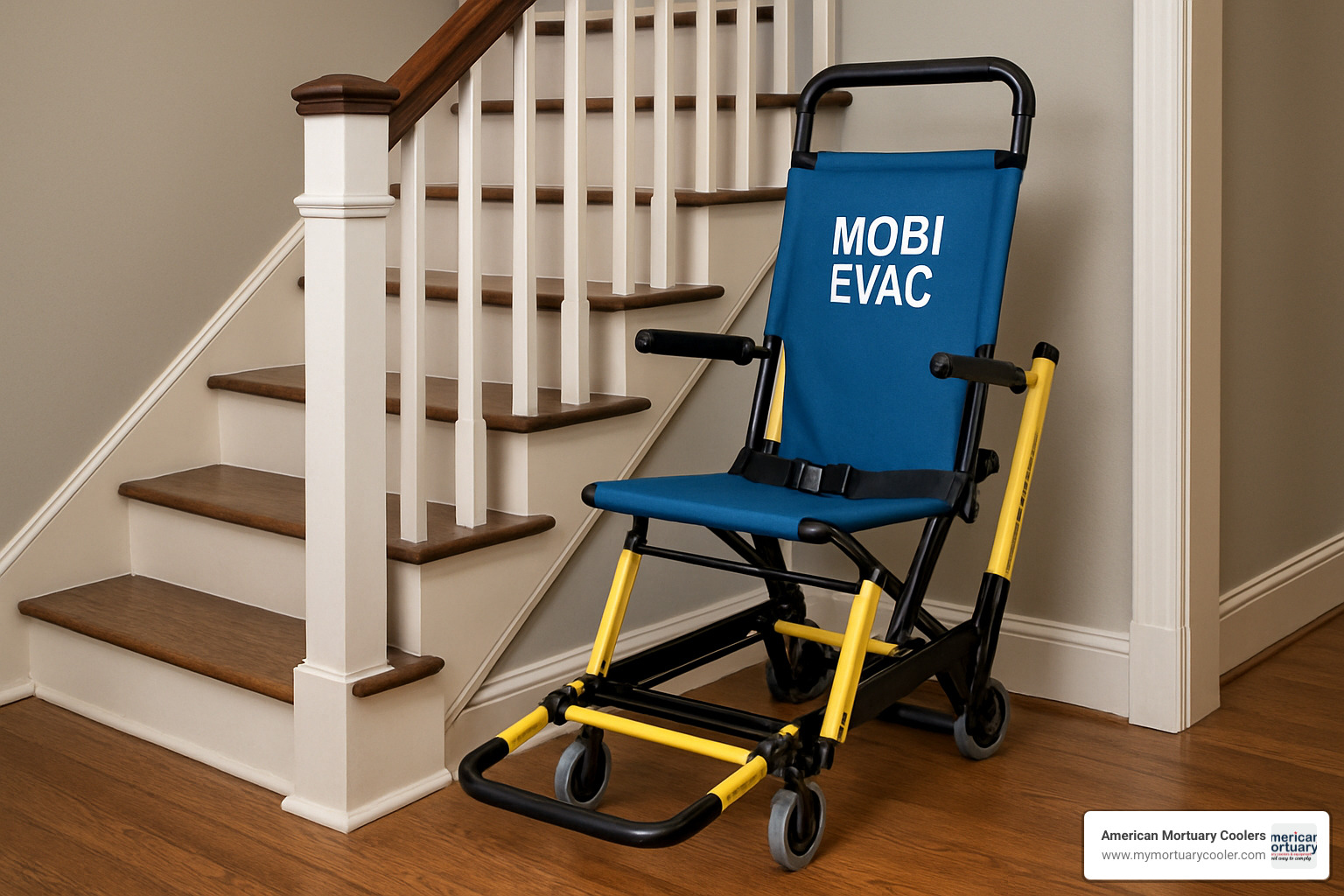
Routine Care Tips
Your cabinet stair is more than just a pretty storage solution—it's a hardworking feature that deserves regular attention. Think of maintenance as giving thanks to this clever space-saver that makes your life easier every day.
Every three months, take a few minutes to lubricate drawer glides and hinges with a silicone-based product. This simple step prevents that annoying sticking and squeaking that can drive anyone crazy. While you're at it, grab your screwdriver and tighten any loose hardware—those drawer pulls and hinges can wiggle loose from daily use.
Once a year, perform a more thorough check-up. Inspect the structural integrity of your stairs, particularly if you store heavier items. Beautiful wine collection or those weighty photo albums? Make sure your cabinets are still happy supporting them.
Don't forget about those hidden corners where dust loves to party. A long-handled duster can help you clean those hard-to-reach spaces that might otherwise be forgotten. For cabinet stairs near bathrooms or exterior doors, be especially vigilant about moisture. A small dehumidifier or moisture-absorbing product can prevent the warping and mold that might otherwise crash your storage party.
Touch-ups matter too. When you notice a scratch or chip in the finish, don't procrastinate—repair small damages before they become bigger problems. Your future self will thank you for this bit of preventive care.
Integrating Assisted-Access Devices
Modern homes should welcome everyone, and your cabinet stair can play a beautiful role in creating an accessible space. Today's designs thoughtfully incorporate features that improve safety without sacrificing style.
For families with young children or elderly members, anti-slip tread treatments provide peace of mind without being an eyesore. Pair these with motion-activated LED strips that gently illuminate the steps when someone approaches—practical magic that prevents midnight stumbles.
If you're caring for family members with mobility challenges, consider how your cabinet stair might incorporate supportive elements. Reinforced handrails offer stability while maintaining a sleek profile. For homes with young explorers, child safety gates can be integrated into the design rather than looking like afterthoughts.
The MOBI Evacuation Stair Chair is a remarkable safety addition that deserves special mention. Supporting up to 500 pounds while weighing only 44.5 pounds itself, this chair can be discreetly stored within your cabinet stair design, ready when needed but invisible until then. It's the safety equipment equivalent of a superhero in disguise.
For homes where wheelchair access is important, consider fold-out ramps or compact wheelchair lifts that can be beautifully concealed within the staircase design. These thoughtful additions make your home welcoming to everyone without compromising your aesthetic vision.
Those with visual impairments benefit from simple additions like contrast-colored edge markings on steps and non-glare surfaces that reduce confusion. Similarly, Braille signage can be neatly incorporated to identify cabinet contents, while lever-style handles replace knobs for easier gripping.
True accessibility isn't just about meeting minimum standards—it's about creating a home where everyone feels welcome and independent. Your cabinet stair can be both beautiful and inclusive with just a little thoughtful planning.
More info about power stair chair
Trends & Innovations in Cabinet Stairs for 2024
The cabinet stair world is buzzing with exciting developments that blend technology, sustainability, and smart design. As someone who's watched this space evolve, I'm thrilled to share what's happening in 2024!
Tech-Forward Features
Remember when stairs were just... stairs? Those days are long gone! Today's cabinet stairs are getting seriously smart:
USB charging stations tucked discreetly into handrails mean your devices can power up while you're grabbing that scarf from under-stair storage. IoT sensors are now monitoring humidity levels in wine storage areas, sending alerts to your phone if conditions threaten your collection.
My personal favorite? Voice-activated lighting that responds to a simple "lights on" command when your hands are full of groceries. No more fumbling for switches!
Fingerprint-recognition locks are providing peace of mind for valuable storage, while gentle-touch automated drawer systems make accessing your items effortless even when you're balancing on one foot. Some homeowners are even integrating smart inventory systems that track what's stored where – perfect for those "now where did I put that?" moments we all have.
These aren't just cool gadgets – they're changing cabinet stairs from simple storage into interactive features that make daily life more convenient and secure.
Eco-Conscious Materials
Sustainability isn't just a buzzword in cabinet stair design anymore – it's becoming standard practice:
Low-VOC finishes are improving indoor air quality, while FSC-certified wood ensures your beautiful storage comes from responsibly managed forests. Many manufacturers are now incorporating recycled steel components that reduce environmental impact without sacrificing strength.
There's something special about cabinet stairs crafted from reclaimed wood – they tell a story while giving materials a second life. For those seeking rapidly renewable alternatives, bamboo and cork are gaining popularity for their quick growth cycles and distinctive aesthetics.
Even the adhesives are getting greener, with water-based options minimizing chemical exposure. And for the truly eco-conscious, solar-powered lighting options are providing energy efficiency that's kind to both the planet and your electricity bill.
CABINET in Germany stands out in this regard – having delivered over 120,000 individual custom cabinet solutions, they emphasize climate-neutral production and hold RAL Emissions Class A certification for their low-emission products.
Beyond materials and technology, we're seeing fascinating design trends emerge. Modular prefab designs are making installation easier, especially in smaller spaces like ADUs (Accessory Dwelling Units). Designers are using 3D CABIsoft planning tools that allow virtual walk-throughs before hammering a single nail.
LED art lighting is changing storage into gallery-worthy display space, while hidden doors concealed within stair risers create magical, secret-passage vibes that delight both children and adults. Smart locks provide secure storage without visible hardware, maintaining clean lines and minimalist aesthetics.
For those hard-to-reach spaces, gas-assisted folding steps are making upper storage areas more accessible than ever before.
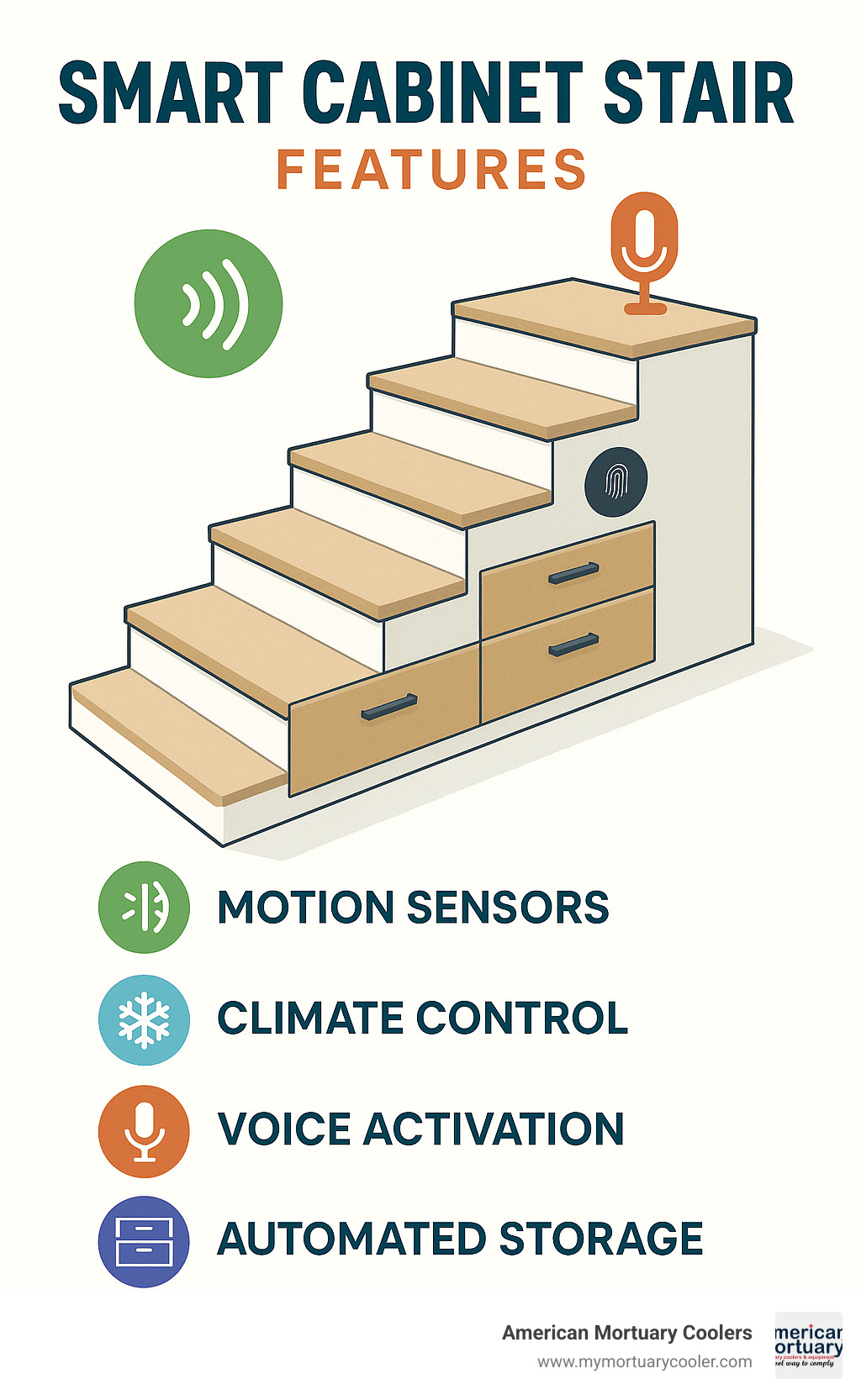
Schränke & Schiebetüren nach Maß
What excites me most about these innovations is how they're making cabinet stairs more functional, beautiful, and sustainable all at once. These aren't just storage solutions – they're becoming centerpieces of thoughtful home design that reflect our values and improve our daily lives.
Frequently Asked Questions about Cabinet Stair Storage
How much weight can cabinet stair drawers hold?
When clients ask me about weight capacity for their cabinet stair drawers, I always explain that it depends on several key factors working together.
Solid wood drawers typically outperform MDF in weight-bearing capability - think of the difference between oak and particleboard. The quality of your drawer slides makes a huge difference too; premium heavy-duty slides can support well over 100 pounds per drawer, while budget options might struggle with half that weight.
The dimensions matter significantly as well. I've seen many homeowners surprised to learn that wider drawers generally support less weight than narrower ones due to leverage forces. And of course, professional installation almost always results in greater capacity than DIY efforts.
For most family homes, well-built cabinet stair drawers comfortably hold between 45-133 pounds - plenty for linens, dishware, or book collections. If you're planning to store something particularly heavy (like that vintage record collection), talk to your builder about reinforced systems with steel components. They can create custom solutions that significantly increase capacity.
Just remember the golden rule of drawer loading: respect the limits! Overloading doesn't just damage the drawer system; it can potentially compromise your entire staircase structure.
Do I need a structural engineer before installation?
I can't stress this enough - for most significant cabinet stair projects, consulting with a structural engineer is money extremely well spent.
Your staircase isn't just a way to get between floors; it's a critical structural element in your home. When we modify staircases by cutting into them or redistributing weight, we're potentially affecting their load-bearing capabilities. Building codes have very specific requirements for staircases for good reason - safety is paramount.
I've seen cases where improper modifications have actually voided home insurance policies, leaving homeowners exposed to significant financial risk. The peace of mind that comes with professional assessment is invaluable.
Now, if you're simply adding surface-mounted cabinets to already enclosed stair walls, you might not need an engineer. But any project involving removing existing structural elements, modifying treads or risers, creating large openings in stairwalls, or installing heavy storage systems absolutely deserves professional review.
The consultation typically costs between $300-$800 - a modest investment compared to the potential costs of structural issues or code violations down the road. Think of it as insurance for your investment.
What is the average timeline for a custom cabinet stair project?
Having overseen dozens of cabinet stair installations, I can tell you that patience definitely pays off with these custom projects. Here's what a typical timeline looks like:
We usually start with an initial consultation and design phase that takes 1-2 weeks. This is where your vision starts taking shape on paper. Once you're happy with the design, we spend about a week finalizing plans and selecting materials.
If permits are required (which is common for structural work), allow 2-4 weeks for that process. Meanwhile, the custom fabrication typically takes 3-6 weeks, depending on the complexity and material availability.
The actual installation is relatively quick - usually 3-7 days - followed by 1-2 days for finishing touches like hardware installation and final adjustments.
All told, you should expect your cabinet stair project to take between 8-14 weeks from initial concept to completion. This timeline aligns with industry standards - CABINET in Germany, for example, delivers and installs their custom under-stair cabinets within 6-8 weeks after order confirmation.
Several factors might extend this timeline: specialty materials with long lead times, particularly complex designs, additional structural work, unexpected issues finded during demolition, or simply trying to schedule during contractors' busy seasons.
If you're working with a tight deadline, ask about semi-custom solutions. These use standardized components adapted to your space, which can significantly reduce wait times while still giving you a beautiful, functional result.
Conclusion
Have you ever looked at the space beneath your staircase and wondered what potential lies hidden there? By embracing cabinet stair solutions, you can transform this often overlooked area into a functional storage haven that improves both your home's utility and its visual appeal. From practical mudroom organizers to neat wine displays, the possibilities truly are limited only by your imagination.
At American Mortuary Coolers, we've built our reputation on maximizing space efficiency in specialized environments. While we primarily focus on creating custom mortuary coolers for funeral homes across the 48 contiguous states, the principles of thoughtful space optimization apply beautifully to home design as well.
The secret to a truly successful cabinet stair implementation isn't complicated – it just requires careful planning, quality materials, and professional installation when the project demands it. By balancing your practical storage needs with your aesthetic vision, you can create a solution that feels like a natural extension of your home while providing invaluable organization.
I've found that smarter homes don't necessarily require more square footage – they simply need more intelligent use of existing space. A well-designed cabinet stair represents this philosophy perfectly, changing an everyday architectural element into a hardworking feature that earns its keep every day.
Whether you're in Johnson City, Atlanta, Chicago, or anywhere else across our service regions, we're delighted to share our expertise in space-efficient design. While our day-to-day work centers on mortuary solutions, the fundamental concept of maximizing every square foot applies universally to creating more functional, organized living spaces.
The beauty of cabinet stair design is how it helps you reclaim space you already own. By working with what you have rather than expanding outward, you're making a sustainable choice that adds value without increasing your home's footprint. That's the kind of practical wisdom that resonates with our approach at American Mortuary Coolers – finding smart solutions that make the most of available resources.
A thoughtfully designed cabinet stair isn't just about storage – it's about changing how you interact with your home. When every inch serves a purpose, life becomes a little more organized, a little less cluttered, and significantly more enjoyable.



















